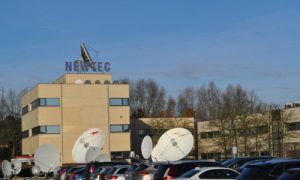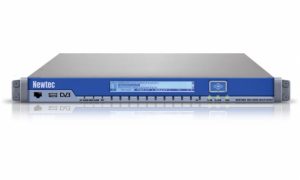
In the latest SpaceWatch Middle East interview series, Torsten Kriening speaks to Thomas Van den Driessche, Chief Executive Officer at Newtec. They discuss the Middle East satellite market, areas for growth, company innovation and the future of the business.
Newtec is one of the biggest satellite communications companies in the Middle East market. What is your current growth strategy in the region and what are the main markets and industry segments do you see growing in the future?
We have been in the Middle East for quite some time. We have our Dubai office and representatives based there so we cover the UAE, Saudi and Kuwait and all the other countries. We have been very successful in the media market in the region, and we have over thirty years of experience in this particular market. Most of the broadcasters are using Newtec equipment but more advanced broadcast media partners are looking increasingly at complete network solutions and not just transmission solutions.This is a growing market in general, and Newtec, with our heritage in the broadcast market, is accomplishing the growing demands of Middle East broadcasters that are shifting from contribution, distribution and transmission into networks. This demand is growing because the media networks of today are more IP-based and bi-directional,instead of just an uplink on a satellite. There are more flyaways, more newsgathering, more exchange of data going on. It is an interesting market and it’s something that Newtec is very good at because it combines the broadcast experience together with experience of VSAT systems. This is a unique combination for Newtec. It’s a growth market because networks are way more efficient than uplinks and reception. There are still a lot of traditional means of broadcasting that can be transformed into more advanced video networks.

Newtec has also grown in the Middle East in terms of forming very strong partnerships. In the last few years, our partnership with Arabsat has grown and, at IBC this year, we signed an MoU with them. We have a very good relationship with Arabsat in different fields. Arabsat has a very interesting strategy of bringing regional payloads specialising (and this is quite new) for the countries in the Middle East. They have tailored their payloads and HTS payloads to the countries. We also signed a major agreement last year with Yahsat which is a fantastic partnership. So I think one of our growth strategies is to make sure we are at the forefront of satellite activities in the Middle East and that we are strategically placed to bring significant leaps in new technologies and new business for the region.
We are continuously expanding our service providers and our distributor base to get more market share. Newtec is a growth company and we have grown 26% this year. This makes us quite unique. Though the satellite industry is in a very dynamic shape, that doesn’t mean that there are a lot of companies growing. Our growth is unique. We have 350 global employees. We have about nine offices around the world. We are investing in more people to bring more business.
We are also working in different verticals. We have talked about media, but I think one of the growth verticals is definitely cellular backhaul. We’ve been very good at providing 4G over our Dialog platform but also over big pipes.
Mobility in general is also interesting for the Middle East, as is government in the region. This is a growing market for us. The other focus for us is SMEs.
We see big consolidations and we provide multi-service platforms. Newtec Dialog is a good example of a multi-service system where you can be very good at one application but you can choose your business based on that. It is one of the engines of our growth also in the Middle East region.
So let’s talk about markets in the Middle East. What’s your view on the Iranian market?
The Iranian market is opening up and that is clear. We have already put some years of effort into it knowing that it was going to open up more. We see potential for sure. It feels like Myanmar to a certain extent. Iran is a very big market with a big need for telecommunications. I think that, on the SME side, the Internet access side, and also on the cellular backhaul side, we see big projects coming up in Iran. The banks always have need for capacity and there is a lot of capacity being sold. It’s only a matter of time before the applications are being deployed. So we have a good feeling about the market in Iran.

I think Saudi Arabia remains a very interesting region. Changes in the government have reflected in the different departments and people making decisions on what to do next. We see a lot of eagerness in Saudi Arabia to be active in building infrastructure and a lot of competition in the country itself to win projects. But there is an interesting dynamic going on in Saudi where everyone is very interested in participating in building something.
In Qatar, we are looking at the situation with Al Jazeera and we expect to see some changes there. We will see how it ends there.
In the North African region, it is tremendously interesting for cellular backhaul and developments for 3G and 4G infrastructure. The big growth market there is cellular backhaul.
Is the mobile market going to be key to Newtec’s future business?
We are at the point of a major breakthrough in the mobility market with the introduction of our Newtec Dialog for the mobility market. We’ve upgraded our terminals and have put in a lot of technical effort to introduce a mobile solution mainly focused at maritime speeds, land speeds and to also look at aeronautical speeds as well. At present, we can cover speeds up to 1000kmph. Eventually it will go up to 1,300kmph.
We have introduced a number of fantastic improvements to our technology to make it very efficient. There are two main areas in which we have improved the Newtec Dialog platform for mobility. First, we have introduced Doppler compensations. We want to be compliant with mobile applications but we also want to be very efficient. Most of our competitors are making their systems more robust so they can handle Doppler effects whilst moving. Instead, we keep our efficiency by compensating for them. Newtec is known for its efficiency. We want to keep that. We take into account that we are moving and we understand the frequency shifts. We compensate for it. We don’t just put more overhead into the system to make it more robust.
We also have a veryinteresting beam switching solution. Typically, when you’re mobile, you end up switching between beams and, of course, the HTS constellations are making the beams smaller so the chances of you moving through a beam are higher. Our beam switching solution comprises two parts. First, automatic acquisition on the terminal itself. Then there is another system that takes over – a mobility management system. We’ve listened very carefully to our customers in the mobile market. They wanted something better than the current solutions, most of which are based on maps and availability which is determined by the terminal but there are big limitations. Instead, we have centralised it and we enable our customers to write scripts on how to move from one beam to another, so we are giving them control of how they would like the system to work. We also have a system that analyses the cost of the beams to find the most cost effective solution. It is a solution where the business decisions of the customer can be used which is a lot more interesting than a purely technical solution. In taking this approach we are differentiating ourselves from traditional mobile solution and I think we will do very well.

What potential do you see for the IoT market?
I think the mobile part is very interesting in terms of agricultural vehicles, for instance, trucks and maybe later on, connected cars. I do see an aggregated solution for IoT in terms of the base stations where they collect information from different devices, locally. I definitely see Newtec as well-placed to do that and it could be one of the early applications for IoT because you can link the readily available terrestrial IoT solutions to satellite in this way. We are following the evolution of the connected car and mobile tracking or information sharing between devices. That’s definitely an area where we have to look at the future chipsets because the cost of the terminal is going to be crucial. The cost will need to be a lot lower to trigger mass adoption.
With the growth of IoT do you think SCADA is dead?
I think IoT is a SCADA application for sure. This is the evolution of SCADA. SCADA has been important solution where the collection of information and monitoring is required and we have delivered solutions where broadband activity was also required for voice calls for engineers.
SCADA has also evolved towards video as well in terms of HD feeds. SCADA has become more advanced. What might be different in the IoT evolution is that you now get cloud-based solutions that are public. SCADA was a very private activity. We have seen attacks on SCADA networks in the past. This made satellite a good solution for SCADA. IoT is a public thing. We want to collect all this information and put it in the cloud and make apps for everyone to use. We want people to have access to their devices like never before. So it’s a more consumer-based application.
Do you see the upcoming LEO constellations as a threat to the established GEO operators? Is this an area that Newtec is involved with?
First of all let me start by saying that Newtec is absolutely looking into this. Any evolution with satellite payloads is a very interesting thing for Newtec. We are a ground technology company that brings new technology to the industry sooner than anyone else. There are many examples of that. We have also set new standards on the physical layer of satellite.
HTS in general is the latest evolution of the payload and everybody has one or is planning one. There is an evolution on the beams and we keep on following this evolution to see if we can find a synergy to exploit the new aspects of the performance. For Newtec it is absolutely not a threat, but an opportunity. Is it a threat to the market? Yes. It is a threat for some. The satellite market needs to remain relevant. It is not competitive to the terrestrial market. It is complementary. So we have to remain relevant. We may need the lower cost of LEO constellations to do this. It is a threat for the traditional way of doing certain applications, that’s for sure.
All the LEO initiatives are not necessarily threatening unless they are disruptive, but most of them have positioned themselves as complementary and serving something that hasn’t been served before. They sometimes shift their focus and strategy but this is a very interesting evolution. I am sure you will see some strategic contracts signed between Newtec and one of the LEO constellations in due course.
What have you introduced recently in terms of competitive technology?
Firstly, the mobility release of Newtec Dialog is very important for us. It actually fills a gap in the mobile markets. On the cruise ship for instance, people want to do what they do at home and today they cannot do it. The mobility release will bring a fresh start to this type of environment. From a technological standpoint, we are bringing DVB-S2X to the VSAT market. We are arguably the first to bring high speed modems for DVB-S2X in a VSAT environment.

In the broadcast market we have been able to put our technology into a gateway product – the MCX 7000 – which is a gateway product and a very dense solution which brings together all the Newtec broadcast products in an environment that is more competitive and leans towards certain applications and also DVB-S2X. It will expand our footprint somewhat in the broadcast market to other applications.
Evolution on our Newtec Dialog is more towards HTS compliancy. More density, more performance for a rack unit so it’s moving towards more separation of IP processing. That type of evolution is going on as well.
Newtec doesn’t advance technology for the sake of technology. It has to make a difference.
We have extremely good return technology called Mx-DMA (add also registered trademark) which we keep expanding and building on. A lot of our market share that we have captured in the last two years is because of that. It brings a competitive advantage for service providers and it gives close to 50% advantage over traditional TDMA and SCPC. A lot of service providers are now using that and it is more cost-effective. This is probably the most disruptive technology that we have brought to the market.
It is clear that Newtec is growing and we are involving a lot of people in this growth. We can offer a lot of competitive advantages. If you haven’t looked at our technology yet, it’s a good time to do so!
SpaceWatch Middle East thanks Thomas Van den Driessche, Chief Executive Officer at Newtec, for the interview.
Original published at: http://spacewatchme.com/2016/12/spacewatchme-interviews-thomas-van-den-driessche-newtec/
 SpaceWatch.Global An independent perspective on space
SpaceWatch.Global An independent perspective on space

